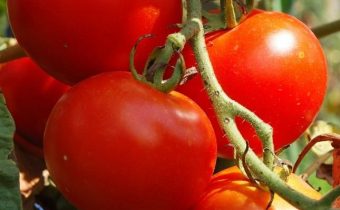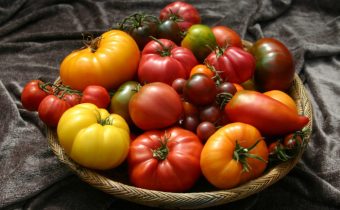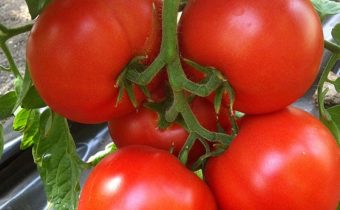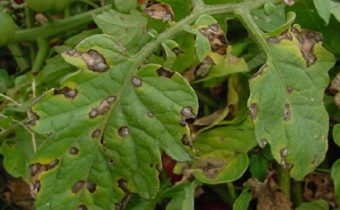Growing tomatoes in a polycarbonate greenhouse: planting and care
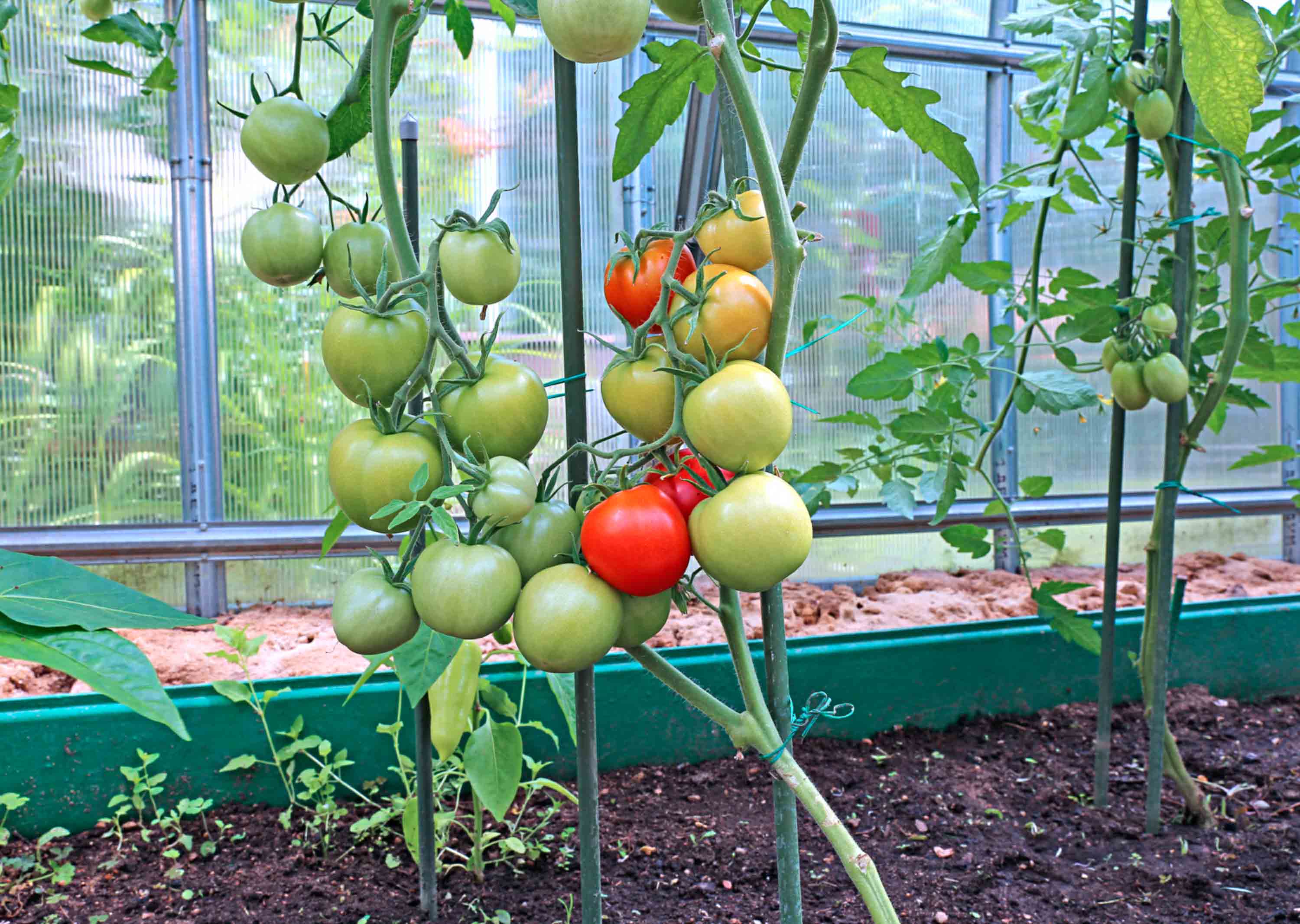
Polycarbonate greenhouse structures are becoming increasingly popular with gardeners. The well-being of tomatoes in greenhouses of light-penetrating polymer depends on the creation of a microclimate suitable for a vegetable.
After all, proper care for tomatoes in a polycarbonate greenhouse is the key to a healthy and decent harvest.
Features of growing
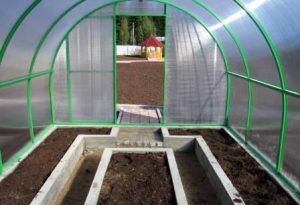 Before you start the cultivation of tomatoes in a polycarbonate greenhouse, you should follow some rules:
Before you start the cultivation of tomatoes in a polycarbonate greenhouse, you should follow some rules:
- The base of the structure must be reliable and stable. After all, strong gusts of wind and the loss of a large amount of snow can destroy a greenhouse poorly fixed on the foundation.
- For the normal development of plants in the greenhouse, heating and additional lighting should be arranged.
- To support tomato bushes during the period of active growth, you need to think of a convenient scheme for tying up plants.
- When using the beds on which tomatoes were grown in the previous season, it is advisable to remove and dispose of the top layer of soil.
- To saturate plants with oxygen, you should consider a high-quality ventilation system.
- For a convenient passage between the bushes of tomatoes to organize the tracks that should be trampled down, sprinkle with sand or sawdust.
- When planting seedlings of tomatoes need to adhere to the distance between plants of at least 40 cm. After all, the bushes planted too close to each other, will lag behind in development, reducing the yield yield by several times.
Greenhouse preparation
If you want to grow a decent crop of tomatoes, the greenhouse should be carefully prepared, carry out all the necessary procedures:
- In early spring, inspect the structure, its compounds for the presence of polymer damage.
- Perform a complete disinfection: wash the polycarbonate from the inside with water with bleach, treat the compounds and the frame with a solution of copper sulphate.
- To carry out the processing of the soil, spilling it with hot water with the addition of iron sulphate or Bordeaux mixture.
- Having prepared places for future beds, check the heating, ventilation and lighting system.
For better penetration of sunlight through polycarbonate on plants, the polymer should be washed from the outside with water with a small amount of detergent or shampoo added, rub with a dry clean rag.
Seed selection
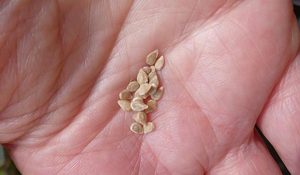 Focusing on the characteristics of varieties and tomato hybrids, for cultivation in a polycarbonate greenhouse, you should choose seeds that differ in yield and endurance to adverse factors. For this, hybrids resistant to elevated daytime temperatures and disease damage are most applicable. Well proven:
Focusing on the characteristics of varieties and tomato hybrids, for cultivation in a polycarbonate greenhouse, you should choose seeds that differ in yield and endurance to adverse factors. For this, hybrids resistant to elevated daytime temperatures and disease damage are most applicable. Well proven:
- Asterix F1. Low-growing hybrid of medium term ripening with medium-sized oval fruits. Differs in the increased resistance to cracking and a fitoftor.
- Suomi F1. Determinant middle late hybrid with small fruits that are perfectly tied at elevated daytime temperatures.
- F1 silhouette.An early hybrid of a semi determinant type with red medium sized fruits. Suitable for growing in a polycarbonate greenhouse in winter.
- Lezfort F1. Semi determinant of very early ripening with large ribbed fruits. Suitable for growing in polycarbonate greenhouses in the autumn-winter period.
- Pink F1 Lady. Early indeterminate with medium-sized pink fruits. It is characterized by increased resistance to pathogen damage, has a powerful growth dynamics.
- Afen F1. Very early indeterminant with large pink fruits. The hybrid is resistant to cracking, increased daytime temperatures and diseases.
- Batyana. Early tall variety, with large pink fruits of heart shape. Suitable for growing in polycarbonate greenhouses in spring. It is resistant to late blight.
- Klondike. Early ripe undersized grade, with fruits of orange color. Differs in the increased productivity and resistance to the increased daytime temperatures.
- Katya. Medium early variety with medium-sized bright red fruits. The tomato is resistant to cracking, suitable for growing in polycarbonate greenhouses in the spring.
- Queen Margo. Variety inderminant with huge cuboid fruits of red color. Tomato is resistant to many diseases and high daytime temperatures.
Growing seedlings
To get healthy and high-quality tomatoes, you need to learn how to independently sow seeds and care for seedlings:
- having picked up suitable containers for growing seedlings, it is necessary to fill them with soil not less than 10 cm high. Soil mixture for sowing seeds should be purchased in specialized stores. After all, sowing plants in the garden land - the defeat of diseases of young plants can not be avoided;
- spreading the seeds on the surface of the moistened soil, bury them to a distance of 0.8 cm-1 cm, sprinkle with earth;
- Cover containers with old newspapers or plastic and put them in a dark, warm place;
- after the appearance of the first loops of the sprouted seedlings, determine the capacity in the most illuminated place by the sun rays, lowering the air temperature by several degrees;
- when a second or third pair of true leaves grows on tomato seedlings, the seedlings need to be smashed into separate containers with a volume of at least 0.5 l. When replanting a plant, you should bury it in the soil as much as possible, trying not to sprinkle the root neck;
- after taking root of young bushes, they should be fed with complex mineral fertilizer according to the instructions;
- in order to prevent the stretching and lodging of seedlings, it must be illuminated with fluorescent lamps in such a way that the light day of the plants is at least 16 hours;
- at the age of 45-55 days to plant the seedlings ready in the greenhouse.
If there is no opportunity to dosachivat seedlings of tomatoes, it can be treated with drugs-inhibitors. Substances that are in the composition of such funds will prevent the stem from stretching, and contribute to the growth of a powerful root system.
Care of planted tomatoes
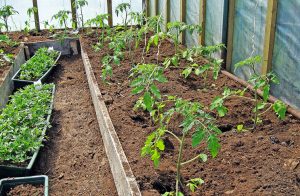 Subsequent care for the planted tomato seedlings consists of the following farming practices:
Subsequent care for the planted tomato seedlings consists of the following farming practices:
- After planting, young plants should be carefully shed the soil by placing a mulch with a layer of at least 15 cm on it in the root zone of tomatoes.
- After 7-10 days, future tomato bushes should be tied up to stakes or wire systems stretched at the top of the greenhouse.
- After tying up the plants, carry out the first feeding with a liquid mullein (0.5 solution per 8 l of water) or nitrogen-containing fertilizer (15 g of nitrate or 15 g of nitroammophoska per 10 l of water). Under each root add 0.5 liters of diluted fertilizer.
- Strictly withstand temperature: during the day the air temperature should not exceed +35 degrees, at night - +16.
- In order not to create a favorable environment for the reproduction of pathogens, conduct timely ventilation of the greenhouse.
- As the bush grows, all lateral stepchildren should be removed, growing the plants into 1-2 stems.
- For a better airing of the plants, it is necessary to cut off all the lower leaves periodically.
- Tomatoes should be fed every two weeks, alternating between root and foliar.
- During the entire period of cultivation of tomatoes in the greenhouse, to carry out preventive measures to prevent diseases and attacks of pests.
In order to get organic vegetables you should not make mineral fertilizers. You can easily cook dressing from organic. To prepare it for 10 liters of water you need to add 500 g of rusks or bread, 200 g of nettle, 200 g of dandelion. Infusion stand in a warm place for 2-3 days, add 500 ml under each root.
Disease control
Tomatoes, cultivated in polycarbonate greenhouses, are affected by diseases much less than those grown in open ground. However, with untimely airing and high humidity, parasitic fungi are inevitable. Some diseases of tomatoes are simply incurable, but most pathogens can be successfully controlled.
Late blight
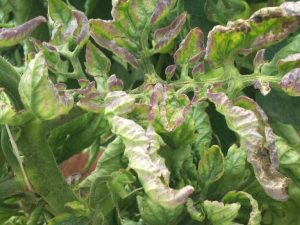 The most famous and dangerous disease. With the defeat of this parasitic fungus on the foliage of tomatoes are formed gray-brown spots with mold bloom. The foliage very quickly turns yellow, twists and dies. At high humidity, night air temperature below +17 degrees, the spores of the phytophthora multiply rapidly and lead to the death of all plants.
The most famous and dangerous disease. With the defeat of this parasitic fungus on the foliage of tomatoes are formed gray-brown spots with mold bloom. The foliage very quickly turns yellow, twists and dies. At high humidity, night air temperature below +17 degrees, the spores of the phytophthora multiply rapidly and lead to the death of all plants.
Control measures
To prevent the disease from the very beginning of the growing season, tomatoes must be treated with copper-containing preparations. In the case of a very strong defeat of spores of the pathogen, should be sprayed with fungicides: Kvadris, Tattu, Ridomil Gold, Topaz. Dilating drugs, strictly following the instructions, maintaining the necessary waiting times.
Necrosis of the stem
Viral disease falling on a tomato bush from infected soil. In the lower part of the stem of the plant, small tears of green color appear with whitish spores, which eventually become gray-brown. The leaves of tomatoes begins to lose its turgor, dry out and fall off. The disease is active for 20 days. After that, 80% of the bushes fade, and the fruits do not even have time to ripen. The development of the virus is promoted by a sharp decrease in the night temperature to +6 degrees, the use of a tool that has not passed disinfection, and the untimely destruction of insect vectors of the virus.
Control measures
To carry out preventive measures in order to avoid the occurrence of core necrosis, the soil in the greenhouse should be disinfected in advance in the greenhouse with the following preparations: Amestar, Carbezim, Previkur, Fitolavin. It is necessary to maintain temperature and humidity that is stable for the normal growth of tomatoes, and every two years to replace the soil layer in the greenhouse. You should only grow disease-resistant varieties and hybrids: Ljana, Sanka, Volgograd, President F1, Rosento F1, Tolstoy F1.
Septoria
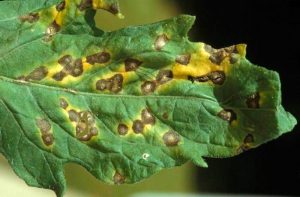 A fungal disease, the first symptom of which is the appearance of light yellow plaques with brown edging on the upper part of the leaves of tomatoes. Gradually, spore-affected areas grow, foliage dries out. The stems of tomatoes begin to frown, and the tops fade. With the late processing of tomatoes, the physiological process is disturbed, the plant does not bloom well and does not form fruit. The disease progresses under the condition of high humidity.
A fungal disease, the first symptom of which is the appearance of light yellow plaques with brown edging on the upper part of the leaves of tomatoes. Gradually, spore-affected areas grow, foliage dries out. The stems of tomatoes begin to frown, and the tops fade. With the late processing of tomatoes, the physiological process is disturbed, the plant does not bloom well and does not form fruit. The disease progresses under the condition of high humidity.
Control measures
In order to defeat the parasitic fungus, it is necessary to carry out preventive processing of plants and soil with copper-containing preparations. In case of severe damage by septoria, plants should be sprayed with industrial fungicides: Topaz, Quadris, Ridomil Gold, Tatto.
Vertex Rot
Physiological disease that occurs due to lack of moisture and active evaporation from the plant itself.For this reason, part of the cells of the tomato fruit that is poured perishes, giving rise to top rot. Disease It may also occur due to excessive nitrogen content in the soil or calcium deficiency.
Control measures
It is necessary to start the fight against the disease in early spring, spilling the soil with hot water with the addition of manganese potassium at the rate of: for 10 liters of water - 1 g of permanganate. During the active growth of tomatoes it is necessary to provide them with sufficient and timely watering. Upon detection of the first signs of the disease, treatment with the following preparations: Nutrivant, Appin, Zircon, Brexil.
Retain moisture in the soil as long as possible using mulch. Organic material should be laid in the root zone of plants with a layer of about 15-25 cm.
Root rot
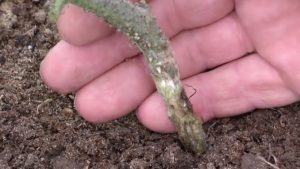 A fungal disease that begins its development at the stage of growing seedlings. To provoke a disease in young plants can poorly disinfected or waterlogged soil. Infected plants planted in the greenhouse begin to darken in the root zone, the bushes lose their turgor even with sufficient watering, become covered with white bloom and die.
A fungal disease that begins its development at the stage of growing seedlings. To provoke a disease in young plants can poorly disinfected or waterlogged soil. Infected plants planted in the greenhouse begin to darken in the root zone, the bushes lose their turgor even with sufficient watering, become covered with white bloom and die.
Control measures
Preventive measures to prevent the development of root rot should be carried out from the very beginning of growing seedlings. To do this, the soil before sowing seeds should be poured with hot water with the addition of manganese. When the first pair of true leaves grows on seedlings, conduct preventive treatment with Previcur.
Cracking fruit
Physiological disease of tomatoes, occurring due to a sharp change in plant growth. Often, the cracking of fruits is triggered by a difference in day and night temperatures, by over-irrigation.
Control measures
To prevent sudden changes in temperature conditions, it is necessary to equip the greenhouse with sufficient ventilation. Regular watering without additional drops will also prevent tomato fruits from cracking. Top dressing should be brought only in the dissolved look after plentiful watering.
A successful method without the use of chemistry in the fight against pathogens is the use of EM-drugs. Live predatory bacteria will neutralize parasitic fungi at the cellular level, increasing the immunity of plants.
The secrets of growing tomatoes in a greenhouse made of polycarbonate
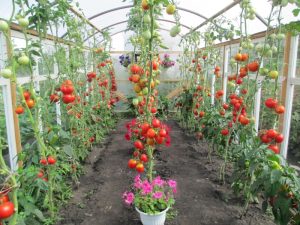 To get a high-quality crop of tomatoes in a polycarbonate greenhouse, you need to know a few secrets:
To get a high-quality crop of tomatoes in a polycarbonate greenhouse, you need to know a few secrets:
- Tomatoes - plants that need enough sunlight. Therefore, they should be planted from north to south, evenly illuminated throughout the day.
- When growing tomatoes in a greenhouse made of polycarbonate, in no case should cucumbers be planted next to them, since the temperatures of these crops do not match.
- For the best development of tomatoes, in a greenhouse should establish a container with a diluted mullein. The gas released during fermentation will contribute to the death of pathogens.
- If you wish to grow tomatoes in a polycarbonate greenhouse without the use of pinching, you can plant ultra early short-growing varieties. Such tomatoes, even without removing the side shoots, will thank for a decent harvest.
How to get an early harvest
Getting an early harvest of tasty meaty tomatoes already by May 1-9 is not at all difficult. To do this, start sowing seeds in the last days of December. For high-quality seedlings need:
- worry about additional lighting with fluorescent lamps or LED lights;
- carry out the treatment of young seedlings with growth stimulants;
- use inhibitor agents.
Before planting seedlings in a permanent place in a polycarbonate greenhouse, you should think about additional heating, lighting and ventilation. In the last decade of March, young plants should be planted, be sure to mumble with a layer of organic matter of at least 25-30 cm.Maintaining the daytime temperature in the greenhouse about +26 degrees, and nighttime - at least +17 degrees, feed the tomatoes every 10-15 days.
For the best education of fruits, it is necessary to carry out processing by the brown. On 1 liter of water, add a teaspoon of boric acid, spray the flower brushes of tomatoes.
How to care for tomatoes in the winter
If you want to have tomatoes on your table all year round and enjoy the grown fruits even in winter, you should find out the features of growing tomatoes in the greenhouse during the cold season:
- seeds should be sown in late August;
- grown seedlings are required to complete illumination, providing a daylight time of at least 17 hours;
- after transplanting to a permanent place, the necessary temperature and humidity should be created in the greenhouse;
- carry out a double treatment with an athlete inhibitor.
Recommendations
To obtain a good yield of tomatoes when cultivating them in polycarbonate greenhouses, you should follow some recommendations:
- To a permanent place in a closed ground tomatoes should be planted with the formed inflorescences;
- plants should be transplanted only with a lump of earth, with a bias of the root system to the north side;
- in order to prevent water from falling on the leaves of tomatoes during irrigation, it is recommended to apply drip irrigation.
Cultivation of tomatoes in polycarbonate greenhouses is a simple matter. Adhering to all the recommendations described, the first tasty and juicy fruits will appear on the table already in the beginning of May.


